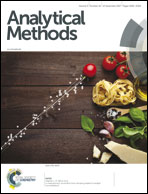Independent macroscopic chemical mappings of cultural heritage materials with reflectance imaging spectroscopy: case study of a 16th century Aztec manuscript
Abstract
Reflectance spectral imaging is a powerful tool for the non-invasive study of cultural heritage objects. Particular visible to short wave infrared (400–2500 nm) spectral features are linked to compositional information. Spectral images can hence be used to generate useful chemical maps. However, in the case of complex mixtures, the global shape of reflectance spectra of pure materials can be affected by the presence of other absorbing materials. While studying heterogeneous polychromatic surfaces in which the same material is found in different color preparations (hence presenting different global absorption characteristics), this aspect can strongly affect the success of the targeted chemical mapping. As a result, several spectral processing steps are necessary to overcome the presence of interfering materials. The case study of the Codex Borbonicus, a precious 16th century Aztec manuscript, is reported herein. Visible and short-wave infrared reflectance images of the document were scanned in situ. To obtain material specific mappings that are not affected by the presence of pigment mixtures, the necessity of applying particular spectral treatments is shown. The flaws and qualities of the resulting chemical images are discussed, along with their general potential for cultural heritage case studies. In summary, independent macroscopic chemical maps of cochineal lake, gypsum, and palygorskite (the clay that composes the mineral matrix of the famous Maya Blue pigment) on the pages of the manuscript were successfully obtained.



 Please wait while we load your content...
Please wait while we load your content...